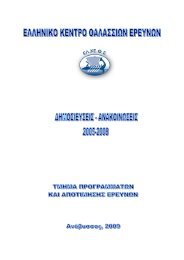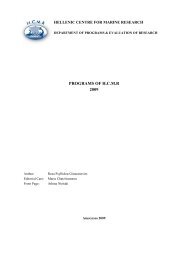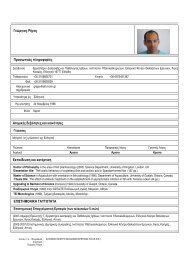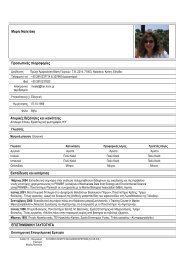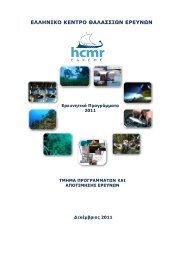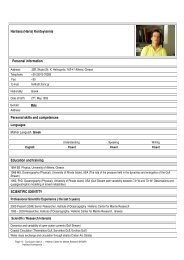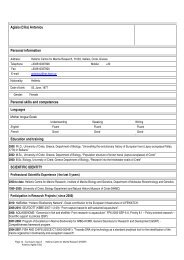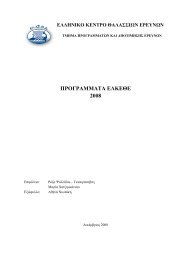2011 Research Programmes of the HCMR - Hellenic Centre for ...
2011 Research Programmes of the HCMR - Hellenic Centre for ...
2011 Research Programmes of the HCMR - Hellenic Centre for ...
You also want an ePaper? Increase the reach of your titles
YUMPU automatically turns print PDFs into web optimized ePapers that Google loves.
Brief Description <strong>of</strong> <strong>the</strong> Study: The aim <strong>of</strong> <strong>the</strong> study is <strong>the</strong> study <strong>of</strong> <strong>the</strong> effects <strong>of</strong> <strong>the</strong> accident <strong>of</strong><br />
“SEA DIAMOND” in Caldera <strong>of</strong> Santorini and <strong>the</strong> leakage <strong>of</strong> petroleum and o<strong>the</strong>r pollutants in <strong>the</strong><br />
marine environment.<br />
European Seas Observatory Network (ESONET-NoE/ 691)<br />
Contract Number:<br />
Scientific Coordinator:<br />
GOCE-036851<br />
Dr V. Lykoussis<br />
Funding: EU (50%) & GSRT (50%)<br />
Starting Year: 2007<br />
Duration: 48 months (01/03/07-28/02/11)<br />
Total Budget:<br />
Study Area:<br />
200.000 € (which 30.000 € will go to Univ. <strong>of</strong> Pireus)<br />
Mediterranean, Black, North, NE Atlantic and Nordic seas.<br />
Scientific Team (ΗCMR): Dr V. Lykoussis, Pr<strong>of</strong>. G.Th. Chronis (till 13/04/09), Dr K. Nittis, Dr I.<br />
Papoulia, Dr D. Sakellariou, N. Lambadariou, Dr S. Alexandri (till 21/06/11)<br />
O<strong>the</strong>r Participants: IFREMER (Coordinator) and 42 European partners.<br />
Brief Description <strong>of</strong> <strong>the</strong> Program: Observatories networked at seafloor level will <strong>of</strong>fer Earth and<br />
ocean scientists new opportunities to study multiple, interrelated processes over time scales ranging<br />
from seconds to decades. These include: a) episodic processes; b) processes with periods from<br />
months to several years; c) global and long-term processes. Episodic processes include, fro<br />
instance, eruptions at mid-ocen ridges and volcanic seamounts, deep-ocean convection at high<br />
latitudes, earthquakes, and biologiclak, chemical and physical impacts <strong>of</strong> storm events. Category<br />
“b” includes processes like hydro<strong>the</strong>rmal activity and biomass variability in vent communities. The<br />
establishment <strong>of</strong> an observatory network will be essential to investigate global processes, such as<br />
<strong>the</strong> dynamics <strong>of</strong> <strong>the</strong> oceanic lithosphere and <strong>the</strong> <strong>the</strong>rmohaline circulation in <strong>the</strong> Ocean.<br />
Knowledge <strong>of</strong> deep water circulation close to <strong>the</strong> seafloor (i.e. Water currents at <strong>the</strong> Benthic<br />
Boundary Layer) is a fundamental objective <strong>of</strong> ESONET. More generally, understanding <strong>the</strong><br />
interactions between ocean, biosphere and geosphere (lithosphere, and solid earth below), leading<br />
to natural hazards (e.g. tsunami, seismicity, submarine landslides) or environmental changes (e.g.,<br />
sea-level, ecosystem changes, greenhouse gas budget) is one <strong>of</strong> <strong>the</strong> main scientific challenges <strong>for</strong><br />
<strong>the</strong> next few decades.<br />
ESONET will facilitate <strong>the</strong> introduction and adoption <strong>of</strong> standards in <strong>the</strong> realm <strong>of</strong> scientific<br />
investigations to enable interoperability on <strong>the</strong> system and component level. Fur<strong>the</strong>rmore <strong>the</strong><br />
project will enhance capacity building in <strong>the</strong> context <strong>of</strong> long term operation <strong>of</strong> observatory systems.<br />
This will result in an improved efficiency regarding scientific cooperation on <strong>the</strong> European level<br />
<strong>for</strong> instance in shared use <strong>of</strong> instrument and sensors on different plat<strong>for</strong>m-types.<br />
The integration <strong>of</strong> leading European companies and SMEs into <strong>the</strong> anticipated Network <strong>of</strong><br />
Excellence will be beneficial to both <strong>the</strong> industrial and <strong>the</strong> academic side. The scientific user will<br />
be able to adjust <strong>the</strong> requirement on <strong>the</strong> observatory system with respect to a technical and develop<br />
new innovative methods <strong>for</strong> <strong>the</strong> prospective ocean observatory system. In this way, ESONET will<br />
stay abreast <strong>of</strong> future changes in <strong>the</strong> technological field.<br />
22



